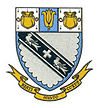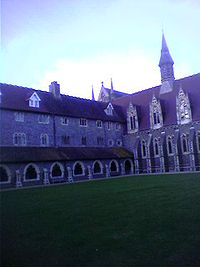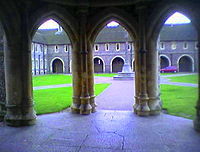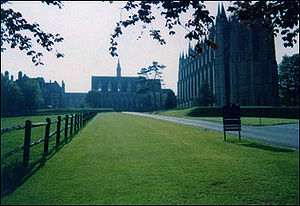- Lancing College
-
Lancing College
(formerly College of St Mary and St Nicolas)Motto 'Beati Mundo Corde'
(Blessed are the pure in heart)Established 1848 Type Independent school Religion Church of England Head Master Jonathan Gillespie MA Chairman Dr. Harry Brünjes Founder Canon Nathaniel Woodard Location Lancing
West Sussex
BN15 0RW
EnglandStudents c.500 Gender Mixed Ages 13–18 Houses 9 Colours Blue and White
Publication The Quad. Former pupils Old Lancing Affiliation Woodard Corporation Website www.lancingcollege.co.uk Lancing College is a co-educational English independent school in the British public school tradition, founded in 1848 by Nathaniel Woodard. Woodard's aim was to provide education "based on sound principle and sound knowledge, firmly grounded in the Christian faith." Lancing was the first of a family of more than 30 schools founded by Woodard (others include Hurstpierpoint College, Ardingly College, Bloxham School and Worksop College).
Typical of major independent schools, Lancing places emphasis on what might be described as tradition — Anglican Christianity (chapel attendance is compulsory for all pupils), and sport (notably football, Eton fives, squash, tennis, hockey and cricket).
The school is based in 550 acres (2.2 km2) of countryside in West Sussex, east of Worthing near the village of Lancing, on the south coast of England. The college is situated on a hill which is part of the South Downs, and the campus dominates the local landscape. The college overlooks the River Adur and the Ladywell Stream, a holy well or sacred stream within the College grounds has pre-Christian significance.[1]
The school is a member of the Headmasters' and Headmistresses' Conference. Girls were first admitted in 1970. The school is dominated by a Gothic revival chapel, and follows a high church Anglican tradition. The College of St Mary and St Nicolas (as it was originally known) was intended for the sons of upper middle classes and professional men; in time this became Lancing College, moving to its present site in 1857.
The school's buildings of the 1850s were designed by the architect Richard Cromwell Carpenter, with later ones by John William Simpson.
Lancing boards boys and girls between the ages of 13 and 18 at a cost of about £27,000 a year. A small number of the students attend Lancing on academic and musical scholarships provided by the school; of the other pupils, some may receive some kind of bursary. Former pupils are referred to as OLs.
In 2005 Lancing was one of fifty of the country's leading independent schools which were found guilty of running an illegal price-fixing cartel which had allowed them to drive up fees for thousands of parents, although the schools made clear that they had not realised that the change to the law (which had happened only a few months earlier) about the sharing of information had subsequently made it an offence.[2] Each school was required to pay a nominal penalty of £10,000 and all agreed to make ex-gratia payments totalling three million pounds into a trust designed to benefit pupils who attended the schools during the period in respect of which fee information was shared.[3] However, Mrs Jean Scott, the head of the Independent Schools Council, said that independent schools had always been exempt from anti-cartel rules applied to business, were following a long-established procedure in sharing the information with each other, and that they were unaware of the change to the law (on which they had not been consulted). She wrote to John Vickers, the OFT director-general, saying, "They are not a group of businessmen meeting behind closed doors to fix the price of their products to the disadvantage of the consumer. They are schools that have quite openly continued to follow a long-established practice because they were unaware that the law had changed."[4]
Contents
School life
The school day begins with 'Roll Call' at 8.15 and ends around 6pm with sports during the afternoons of alternate days. At 7pm there are two hours of 'evening school' where pupils are expected to remain in their studies and complete any prep that may have been set during the academic day. Pupils are also expected to attend lessons on Saturday mornings.
The college is divided up into houses, each house resident to between 30 and 80 pupils.
House Colours Number Gender Type Housemaster/mistress Named after Head's Red/Rose 1 M Day Mr A Chappell formerly The Head Master's House Second's Silver/Maroon 2 M Boarding Mr D Connolly formerly The Second Master's House School Purple/Silver 3 M Boarding Mr C Mole consists of the former Olds and Sanderson (New) Houses Field's Rose/White 4 F Boarding Mrs M Creer The Rev. Edmund Field Gibbs' Silver/Purple 5 M Boarding Mr M J H Smith Henry Martin Gibbs Sankey's Green 6 F Day Miss N Dragonetti John Sankey, 1st Viscount Sankey Teme Green/blue 7 M Boarding Dr S Norris The River Teme Manor Yellow 8 F Boarding Miss C Parkinson Manor house, a house of the school in the first half of the 20th century Handford Blue 9 F Boarding Miss McKane Basil Handford Each house has a distinctive set of 'colours' which are awarded to students for merit and/or commitment for representing the house. The award allows male students to wear a house tie.
Besides academic study pupils are involved in activities that include football, rugby, tennis, squash, badminton, lacrosse, basketball, fives, hockey, running, debating, farming, riding, clay pigeon shooting, target rifle shooting, Duke of Edinburgh's Award Scheme, sailing, and the Combined Cadet Force.
Chapel
The foundation stone of the college chapel was laid in 1868, but the chapel itself was not finished in Woodard's lifetime. In fact, the chapel remains unfinished. It stands at about 50 metres (with foundations going down 20 metres into the ground), but the original plans called for a tower at the West end which would raise the height to 100 metres. One reason that the chapel ended up as high as it did was that Woodard insisted that it be built to its full height at one end first, so that even if he died before completion the height could not be cut down to save money. The chapel is built in the English gothic style of the 14th century, with 13th century French influences. It was designed by R. H. Carpenter and William Slater, and is built of Sussex sandstone from Scaynes Hill.
The chapel was dedicated to St Mary and St Nicolas in 1911, although the college worshiped in the finished crypt from 1875. Inside can be found, amongst other things, the tomb of the founder, two organs, and a rose window designed by Stephen Dykes Bower which is the largest rose window in England being 32 ft in diameter. The chapel itself is the largest school chapel in the world.[5]
The eastern organ is a two manual mechanical organ built by the Danish firm, Frobenius and was installed and voiced 'in situ' in 1986. That year marked the completion of the rebuild of the four manual Walker organ at the west end of the chapel - both of which were showcased in the opening concert by the American organ virtuoso, Carlo Curley.
A stained glass window was recently commissioned in memory of Trevor Huddleston OL, and was consecrated by Desmond Tutu on Tuesday 22 May 2007.
The chapel is open to the public every day, Monday to Saturday from 10.00 until 16.00, and Sunday from 12.00 until 16.00. Full school services are held every Wednesday morning during term time at 08.35, and on certain Sundays throughout the year. There is also a eucharist every morning at 07.40, and benediction on a Friday evening followed by a lower school service on Saturday mornings at 8:25.
Lancing's chapel "symbolises the importance of Christian worship" at the college. Every year the building brings thousands of visitors to its doors.
Campus
Most school buildings and boarding houses are positioned around the central quads with the chapel positioned adjacent to the college drive. The school has an operational farm, river access, squash courts, fives courts, swimming pool, a multigym, weightroom, two all weather astro-turfs, twenty-eight tennis courts, two theatres, two libraries and extensive classrooms.
The school is one of only a small number in the country to have Eton fives courts. The Upper Field's cricket square is most highly regarded.
During World War II, students were evacuated to Downton Castle in Herefordshire.[6] Both the main college and the prep school buildings were requistioned by the Admiralty and became part of the Royal Navy shore establishment HMS King Alfred.
Developments
Despite the principles of Victorian austerity on which the school was founded, Lancing has recently completed a number of developments that include a new design centre. The new art school was opened by HRH the Duke of Gloucester in September 2009.
A development council is operating under the chairmanship of Sir Tim Rice. It acts in an advisory capacity on development and fundraising matters.
In 1856 Lancing created its own code of football which (unlike other school codes) was regarded as a means of fostering teamwork[7]
Notable alumni
Arts
- Tim Battersby, composer, musician and lyricist
- David Bedford, composer and musician
- Geoffrey Bush (1920–1998), composer
- Giles Cooper (1918–1966), radio dramatist
- Frederick Gore (1913–2009), artist, educator and author
- Brodrick Haldane (1912–1996), society portrait photographer (son of Chief of Clan Haldane)
- Henry Hardy, editor and composer
- Sir Peter Pears (1910–1986), tenor
- Edward Piper (1938–1990), artist (son of John Piper)
- Sir Tim Rice, lyricist
- Neil Richardson (composer) (1930–2010), composer
Literature
- Stuart Cloete (1897–1976), novelist
- Andrew Crofts (author), ghostwriter
- Plantagenet Somerset Fry (1931–1996), historian and author
- Mark Mills (writer), novelist and screenplay writer
- Jan Morris, author and journalist
- Tom Sharpe, novelist
- Evelyn Waugh (1903–1966), novelist
- Philip Womack, author and journalist
Broadcasting, theatre and film
- George Baker (1931-2011), actor
- Christopher Hampton, playwright
- Sir David Hare, playwright
- Alex Horne, comedian
- Royce Ryton (1924–2009), actor and playwright
- Jeremy Sinden (1950–1996), actor
- Jamie Theakston, TV and radio presenter
- John Williams (actor) (1903–1983), actor
Politics and law
- Nana Addo Dankwa Akufo-Addo, Minister of Foreign Affairs, Ghana (2003–2007), 2008 Ghanaian presidential candidate
- Greg Barker, Member of Parliament for Bexhill and Battle, Minister of State for Energy and Climate Change (2010-)
- Nicholas Browne-Wilkinson, Baron Browne-Wilkinson, Vice-Chancellor of the Supreme Court (1985–1991), Senior Lord of Appeal in Ordinary (1995–2000)
- Tom Driberg, Baron Bradwell (1905–1976), Member of Parliament for Maldon (1942–1955) and Barking (1959–1974), Chairman of the Labour Party (1957–1958)
- Sir Roger Fulford (1902–1983), President of the Liberal Party (1964–1965)
- Walter Loveys (1920–1969), Member of Parliament for Chichester (1958–1969)
- Sir Robert Megarry (1910–2006), Vice-Chancellor of the Chancery Division (1976–1981), Vice-Chancellor of the Supreme Court (1982–1985)
- Patrick Maitland, 17th Earl of Lauderdale (1911–2008), Member of Parliament for Lanark (1951–1959)
- Hugh Molson, Baron Molson (1903–1991), Member of Parliament for Doncaster (1931–1935) and High Peak (1939–1961), Parliamentary Secretary to the Ministry of Transport and Civil Aviation (1953–1957), Minister of Works (1957–1959)
- William Rhys Powell, barrister, Member of Parliament for Corby (1983–1997)
- Sir Charles Arthur Roe (1841–1926), Chief Justice of the Lahore High Court (1895–1898)
- John Sankey, 1st Viscount Sankey (1866–1948), Lord Justice of Appeal (1928–1929), Lord Chancellor of Great Britain (1929–1935)
- William Thomas Wells (1908–1990), barrister, Member of Parliament for Walsall (1945–1955) and Walsall North (1955–1974)
- Rob Wilson, Member of Parliament for Reading East, Parliamentary Private Secretary to the Culture, Olympics, Media and Sport Secretary (2010-)
Diplomatic service
- Sir Philip Adams (1915–2001), British Chargé d'affaires to Sudan (1954–1956), British Ambassador to Jordan (1966–1970), British Ambassador to Egypt (1973–1975)
- David Lloyd (diplomat), British Ambassador to Slovenia (1997–2000)
- Sir Christopher Meyer, British Ambassador to Germany (1997), British Ambassador to the United States (1997–2003)
- Andrew Page, British Ambassador to Slovenia (2009-)
- Sir Elwin Palmer (1852–1906), diplomat and colonial administrator
- Sir John Richmond (diplomat) (1909–1990), British Ambassador to Kuwait (1961–1963), British Ambassador to Sudan (1965–1966)
- Humphrey Trevelyan, Baron Trevelyan (1905–1985), British Chargé d'affaires to China (1953–1955), British Ambassador to Egypt (1955–1956), British Ambassador to Iraq (1958–1961), British Ambassador to Russia (1962–1965), last High Commissioner of Aden (1967)
- Edward Twining, Baron Twining (1899–1967), Governor and Commander-in-Chief, North Borneo (1946–1949); Governor and Commander-in-Chief, Tanganyika (1949–1958)
- Sir Armigel Wade (1890–1966), Colonial Secretary in Kenya (1934–1939)
Sciences
- Sir Roy Calne, pioneer of liver transplantation
- Basil William Sholto Mackenzie, 2nd Baron Amulree (1900–1983), physician and geriatrician
- Charles Francis Massey Swynnerton (1877–1938), naturalist
- Gino Watkins (1907–1932), Arctic explorer
The Church
- Michael Ball, suffragan Bishop of Jarrow (1980–1990) and Bishop of Truro (1990–1997)
- Peter Ball, suffragan Bishop of Lewes (1977–1992) and Bishop of Gloucester (1992–1993)
- Christopher Russell Campling, Dean of Ripon (1984–1995)
- Thomas William Cook (1866–1928), Bishop of Lewes (1926–1928)
- Charles John Corfe (1843–1921), inaugural Bishop in Korea (1889–1904)
- Anthony Charles Foottit, Bishop of Lynn (1999–2003)
- Sir Francis Heathcote, 9th Baronet (1868–1961), Bishop of New Westminster (1940–1951)
- Trevor Huddleston (1913–1998), Archbishop of the Indian Ocean (1976–1984), Bishop of Masasi (1959–1968), Bishop of Stepney (1968–1978), Bishop of Mauritius (1978-?)
- John Dudley Galtrey Kirkham, Bishop of Sherborne (1976–2001)
- Lewis Evan Meredith (1900–1968), Bishop of Dover (1957–1964)
- Cyril Jonathan Meyrick, Dean of Exeter
- David Reindorp, vicar of Chelsea Old Church, Chaplain to the Honourable Artillery Company and to the Worshipful Company of Fan Makers
- Erik Routley (1917–1982), Congregational minister, composer and musicologist
- James Leo Schuster (1912–2006), Bishop of St John's (1956–1980)
- Henry Edward Champneys Stapleton, Dean of Carlisle (1988–1998)
- Mark Napier Trollope (1862–1930), third Bishop in Korea (1911–1930)
Armed forces
- Lt-Gen Sir Louis Jean Bols (1867–1930), Chief of Staff to the Third Army (World War I), General Officer Commanding the 24th Division (1917), Chief Administrator of Palestine (1919–1920), Governor of Bermuda (1927–1930)
- Brig Sir Iltyd Nicholl Clayton (1886–1965), policy-maker active in formation of the Arab League, special advisor on Arab Affairs British Middle East Office (1943–1945), Minister attached to the British Embassy in Cairo (1947–1948)
- Col. Andrew Croft (1906—1998), explorer and member of the Special Operations Executive and Military attaché to Sweden (World War II)
- Lt-Gen Sir John Fullerton Evetts (1891–1988), General Officer Commanding 6th Infantry Division (1941), Assistant Chief of the Imperial General Staff (1942–1944), Master-General of the Ordnance (1944–1946)
- Sqn Ldr Prince Emanuel Galitzine (1918–2003), Spitfire pilot
- Col St George Corbet Gore (1849–1913), Surveyor General of India (1899–1904)
- George Henry Wellington Loftus, 7th Marquess of Ely (1903–1969), soldier
- Galbraith Lowry-Corry, 7th Earl Belmore (1913–1960), soldier
- Air Vice-Marshal John Frederick Powell (1915–2008), Director of Education Services RAF
- Surgeon Rear Admiral P.D. Gordon Pugh, high ranking Royal Navy officer
- Sqn Ldr / Lt Cdr Jeffrey Quill (1913–1996), Spitfire test pilot
- Lt-Gen Sir Alan Reay KBE, director-general of the RAMC (1981–1985)
- Gen Sir Neil Ritchie (1897–1983), Commander-in Chief, Eighth Army (1941–1942), Commander-in-Chief, XII Corps (1943–1945), Commander-in-Chief Far East Land Forces (1947–1948), Aide-de-Camp General to George VI (1948–1951).
- Maj-Gen David Rutherford-Jones, Commandant of the Royal Military Academy, Sandhurst (2007–2009), Military Secretary (2009-2011).
- Air Vice-Marshal Sir Stanley Vincent (1897–1976), Air Officer Commanding No. 226 Group (1942–1943), Air Officer Commanding No. 13 Group (1943–1944), Air Officer Commanding No. 221 Group (1944–1945), Air Officer Commanding No. 11 Group (1948–1950), only RAF pilot to shoot down the enemy in both world wars
- Maj-Gen Sir Alexander Wilson, (1858–1937) former Colonel of the Argyll and Sutherland Highlanders and Lieutenant Governor of Jersey (1916–1920)
- Rear-Admiral Sir Robert Woodard, Commander of the Royal Yacht Britannia (1985–1990)
Business
- Sir Edgar Beck (1911–2000), Chairman (1961–79) then President (1981–2000) of Mowlem
- Sinclair Beecham, co-founder of Pret a Manger
- Sir John Gilbert Newton Brown (1916–2003), Publisher of the Oxford University Press (1956–1980)
- Sir Michael Darrington, Managing Director of Greggs
- Stephen Green, Baron Green of Hurstpierpoint, Group Chairman of HSBC Holdings plc (2006–2010), Minister of State for Trade and Investment (2011-)
- Sir Derek Alun-Jones (1933–2004), Chairman of Ferranti (1982–1990)
- Raymond Kwok Ping Luen, vice-chairman and Managing Director of Sun Hung Kai Properties, Chairman of SmarTone Telecommunications Holdings Limited
Sport
- Reginald Birkett (1849–1898), England footballer, 1880 FA Cup winner, England national rugby player, scorer of England's first ever rugby union try.[8]
- H.J.C. Turner (1850-?), England national rugby player, player in inaugural rugby union international match in 1871.[9]
- Edward Cawston (1911–1998), Sussex cricketer
- Edgar Field (1854–1934), England footballer, 1880 FA Cup winner
- Andrew Frampton, Millwall FC footballer
- Henry Hammond (footballer) (1866–1910), England footballer
- Elphinstone Jackson (1868–1945), England footballer and co-founder of the Indian Football Association
- Richard Meade, Olympic gold medal winning equestrian
- Francis Woodcock (1925–1994), Brighton FC footballer
Academia
- Rajnarayan Chandavarkar (1953–2006), historian and author
- Nicholas Goodrick-Clarke, Nazi era scholar
- Michael J. Kennedy, Dean of Faculty of Science and Professor of Geology, University of Dublin
- Sir Max Mallowan (1904–1978), archaeologist and scholar, Director of the British School of Archaeology in Iraq
- Brian Manning (1927–2004), Marxist historian
- Henry Nettleship (1839–1893), English classical scholar
- Peter Self (1919–1999), scholar
- John Dover Wilson (1881–1969), literary critic and scholar
Miscellaneous
- Desmond Wyndham Otho FitzGerald (1901–1949), 28th Knight of Glin
- Prince George (Georgie Vladimirovich) Galitzine (1916–1992), soldier
- Charlie Gilmour Model/protestor[10]
- Mowbray Henry Gordon Howard, 6th Earl of Effingham (1905–1996)
- John Lowry-Corry, 8th Earl Belmore, art collector
- Thomas Percy Henry Touchet-Jesson, 23rd Baron Audley (1913–1963), soldier, playwright
Notable former staff members
- Richard Budworth (1867–1937), former Master and an English rugby union forward, original member of the Barbarians Football Club
- Sir William Gladstone, former Head Master and Chief Scout of the United Kingdom, descendent of William Gladstone, 19th Century Prime Minister.
- G.O. Smith, sportsman rated the greatest footballer of the nineteenth century
- John Inge, former chemistry teacher and Assistant Chaplain and current Bishop of Worcester
- Edward Clarke Lowe (1823–1912), former Second Master, Provost of St Nicholas College Lancing and key participant in the foundation and development of the Woodard Schools
- Arthur Temple Lyttelton, Provost of St Nicholas College Lancing, third Bishop of Southampton (1898–1903)
- Sheppard Frere, former House Master, Professor of the Archaeology of the Roman Provinces at the University of London (1961–1966), Professor of the Archaeology of the Roman Empire at Oxford University
Hoe Court
The College owns a number of properties based along the College Drive and all the properties in Hoe Court, a road extending from the rear of the College towards the village of Lancing.
Lancing College Preparatory School at Mowden
Lancing College Preparatory School at Mowden is an independent nursery, pre-preparatory and preparatory School for approximately 195 children between the ages of 3 and 13. The headmaster is a member of the Independent Association of Preparatory Schools.
Mowden School, as it was originally known, was founded by B A Snell at Mowden Hall, in Essex, in 1896. In 1901, it moved to Lansdowne Place, Hove and in 1913 moved again to its present site. Edward Snell took over from his father in 1937 and, on his death in 1973, his son, Christopher, became headmaster.
In September 2002, the school passed into the care of Lancing College and the current headmaster, Alan Laurent, took over from the Snells. Although the house was purpose built for a preparatory school in 1913 by Christopher Snell¹s grandfather, there has been a continuing programme of modernisation and development.
In addition to two dedicated IT rooms, each classroom has its own computer, projector and interactive smartboard and there is a well-equipped science laboratory, technology room and an attractive library and reading room. Spacious sports fields surround the school, which accommodate pitches for all the main games and sports, including an all-weather Astroturf area.
Traditionally the school was for boys only, but in September 2002, girls were accepted for the first time and the school became co-educational.
Mowden School became Lancing College Preparatory School at Mowden (or Lancing Prep as it is known) in September 2005.
In 2008, an ISI Inspection team concluded that, 'Lancing College Preparatory School meets its aims outstandingly well. It does this by achieving high quality in every aspect of what it provides'.
Headmasters of Lancing College
- Henry Jacobs (Aug–Dec 1848)
- Charles Edward Moberly (1849–1851)
- John Branthwaite (1851–1859)
- Henry Walford (1859–1861)
- Robert Edward Sanderson (1862–1889)
- Harry Ward McKenzie (1889–1894)
- Ambrose John Wilson (1895–1901)
- Bernard Henry Tower (1901–1909)
- Canon Henry Thomas Bowlby (1909–1925)
- Cuthbert Harold Blakiston (1925–1934)
- Frank Cecil Doherty (1935–1953)
- John Christopher Dancy (1953–1961)
- Sir Erskine William Gladstone KG Bt (1961–1969)
- Ian David Stafford Beer (1969–1981)
- James Stephen Woodhouse (1981–1993)
- Christopher John Saunders (1993–1998)
- Peter M. Tinniswood (1998–2005)
- Richard R. Biggs (acting, 2005–2006)
- Jonathan Gillespie (Sept 2006–present)
References
- ^ Our Lady's Well (Lancing) [Ladywell Spring] Holy Well or Sacred Spring : The Megalithic Portal and Megalith Map:
- ^ Independent schools face huge fines over cartel to fix fees - Times Online
- ^ OFT names further trustees as part of the independent schools settlement - The Office of Fair Trading
- ^ "Private schools send papers to fee-fixing inquiry". The Daily Telegraph (London). 2004-01-03. http://www.telegraph.co.uk/news/1455730/Private-schools-send-papers-to-fee-fixing-inquiry.html. Retrieved 2010-03-15.
- ^ Cities, Events, Accommodation & Attractions in South East England[dead link]
- ^ Liberal England blog by Jonathan Calder - "Shropshire on the screen", July 12, 2005
- ^ J. Lowerson and J. Myerscough, Time to Spare in Victorian England (Brighton: Harvester, 1977) pp 119-20, cited in Football: The First Hundred Years. The Untold Story. Adrian Harvey, Routledge, 2005
- ^ The Lancing College magazine, Issue 2, Publisher C. Cull and Son, 1877
- ^ The Lancing College magazine, Issue 2, Publisher C. Cull and Son, 1877, p1248
- ^ Justice for Charlie Gilmour: Should the law take class into account? | The Economist
External links
- Lancing College school website
- The Woodard Corporation - A Group of Public Schools
- Old Lancing: OL's
- Lancing Old Boys Football Club
- Lancing Old Boys Tennis
- The Old Lancing Lodge (Freemasons)[dead link]
- Lancing Prep school website
Owned Schools Abbots Bromley School for Girls · Ardingly College · Bloxham School · Denstone College · Ellesmere College · Grenville College · Hurstpierpoint College · King's College · Lancing College · Peterborough High School · Prestfelde School · Queen Mary's School · Ranby House School · The Cathedral School · The King's School · Worksop College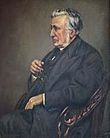
Affiliated Schools Bishop Stopford School · Crompton House Church of England School · Derby Grammar School · Derby High School · St Olave's and St Saviour's Grammar School · St Saviour's and St Olave's Church of England School · The Bishop of Hereford's Bluecoat School · The Bishops' Blue Coat Church of England High SchoolAcademies The Littlehampton Academy · The Sir Robert Woodard AcademyCategories:- Educational institutions established in 1848
- Schools with Combined Cadet Forces
- Member schools of the Headmasters' and Headmistresses' Conference
- Boarding schools in West Sussex
- Co-educational boarding schools
- Woodard Schools
- Independent schools in West Sussex
- Old Lancing
- 1848 establishments in England
Wikimedia Foundation. 2010.

